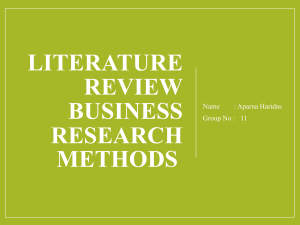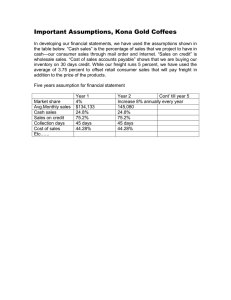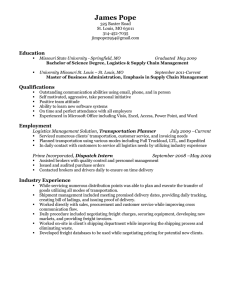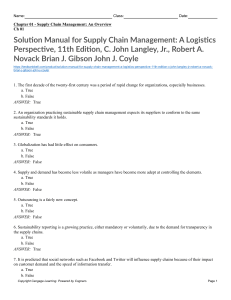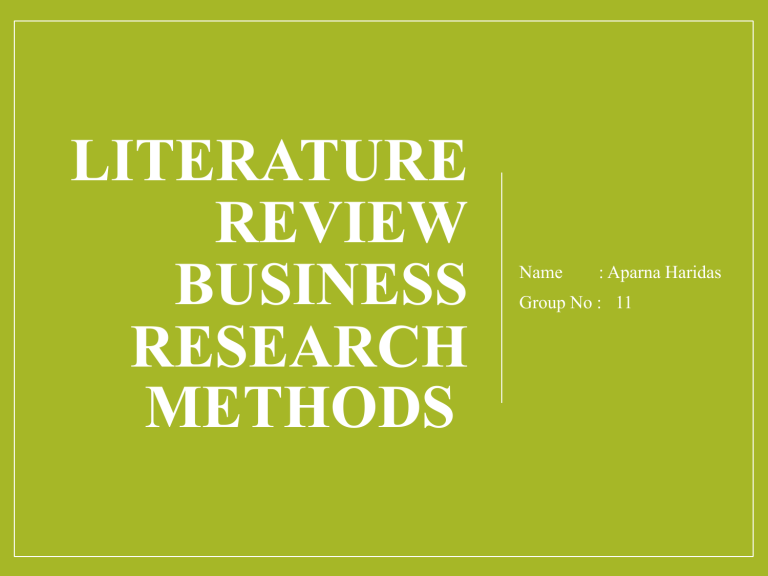
LITERATURE REVIEW BUSINESS RESEARCH METHODS Name : Aparna Haridas Group No : 11 JOURNAL 1 The impact of COVID-19 on transport volume and freight capacity dynamics: An empirical analysis in German food retail logistics Author : Dominic Loske Published : Transportation Research Interdisciplinary Perspectives by Elsevier Ltd. https://www.sciencedirect.com/science/article/pii/S2590198220300762 Objective: To analyze a.The impact of the COVID-19 outbreak and changing purchasing behavior on the transport volume growth in food retail logistics. b.The resulting implications of freight capacity demand of retail logistics. Research Methodology : [cont'd] Employing primary data collected from the company's route planning software and secondary data collected from European Union Open Data Portal(2020), statistical analysis was conducted to understand the interdependencies between different variables. Statistical tools used are regression and correlation analysis. Statistical tests conducted include residuals versus fitted plot, normal Q-Q, scale location, and residuals versus leverage. Findings: • The number of new COVID-19 cases has a significant impact on the increase of total transport volume for dry products for the examined depots as regression analysis shows a strong linear statistical relationship. • The volume of all other product group, ie. Frozen products, fruit and vegetables, dairy products, and raw fish and meat are independent form the new COVID-19 cases. • To summarise for non cooled products/dry products, transport capacity demand will rise with rise in covid cases but not for the other set of products. • A large number cooled transport capacity and non cooled transport capacity is available in the freight market currently due to shutting down of activities by gastronomy and manufacturing sectors respectively. [cont'd] JOURNAL 2 Strategies to mitigate the impact of COVID-19 on supply chain disruptions: a multiple case analysis of buyers and distributors Author : Atif Saleem Butt Published : The International Journal of Logistics Management by Emerald Publishing Limited. https://www.emerald.com/insight/content/doi/10.1108/IJLM-11-20200455/full/html Objective: • An exploratory research on the steps/countermeasures taken by buying and distributing firms to address supply chain disruptions caused by COVID-19. Research Methodology: [cont'd] • Exploratory multiple case study methodology. • Primary data collected by semi structured interviews. • Secondary data collected from firms’ reports, websites, and social media for triangulation. Sampling Techniques: • Purposive and snowball sampling techniques. Software Used: • NVIVO FINDINGS AND CONCLUSION Buyer’s perspective: Distributor’s perspective: 1. Agile production 1. Modifying inventory policies Production rescheduling Naturally inflate inventory positions 2. Focus on tier 1 supplier risk 2. Evaluate alterative inbound options Active communication Formulating alternate plans 3. Enhanced inbound material visibility Examine supplier’s shipment status Examine supplier’s production schedule Using rail routes and sea ports or combination of both 3. Evaluate alternate sources of supply Work with secondary suppliers 4. Closing production facilities Re-route production to other locations Scope: Study should be conducted with larger sample sizes from various parts of the world for finding strategies effective for global supply chain. Research towards understanding how the policies of companies should evolve to overcome any supply chain disruptions.
